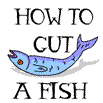Gutting a Fish
Created | Updated Jan 7, 2012

With all of the survival shows on the television, it is becoming increasingly apparent that the vast proportion of the first world population would, even if they managed the hard part of catching one, be unable to gut and clean a fish. But there are those occasional times when we are forced to survive by our wits, and in these situations, some good fish-gutting knowledge might be valuable.
Fish are mainly stupid aquatic creatures, but they have a well developed set of instincts. There are many ways of catching them, some of which may appear in the Guide. This entry, however, assumes that the fish has been already been caught.
Killing the Fish
Once the fish is in your hands the most immediate problem is preventing it from escaping back to its watery home. As this entry assumes that you are going to want to eat the beastie, the best way to stop it is to kill it, and kill it quickly.
The easiest method of executing the fish is to grab it firmly by the tail and, in a smooth, overhand, swinging action, whack it against something hard1. The fish should hit the object just behind the head, with the idea being to break its neck. This can take some practice, so you may need to repeat the action, maybe more than once.
A second way, albeit somewhat less effective, is to hit the fish with something hard. Again you want to hit the fish just behind the neck in an attempt to break its neck. Something with a long handle is best, say an oar or something similar, as the part that is doing the hitting has to be travelling at a fair pace to do the business properly. Also, you don't want your fingers getting in the way.
One last way, which many find distasteful, is to leave the fish to suffocate in the air. This is the poorest method, as the fish takes a long time to die - they flop around, and try and get back to the water. A fish of any decent size could easily flop back into the water if left on a more or less flat surface. Also some fish - eels in particular - can survive quite a while out of water and can have quite decent mobility on land2. If you really insist on killing a fish in this manner, a box is an essential item, preferably with a lid.
So Now Your Fish is Dead
Now that the fishy soul has passed on, its earthly carcass needs to be cleaned. For this part, you will need a sharp knife. First of all, (holding the fish carefully) slice the belly from where the gills meet the head to the anus. Do not cut too deeply, or you will pierce the digestive system. Once the internal organs are visible, gently pull the insides just behind the head and slice, separating the organs from the head. Repeat this process at the anus to separate the organs from the other end. These cuts are to sever the internal organs from their respective openings so they can come out in a relatively clean manner.
Now, depending on the size of the fish, use your finger or hand to pull the organs from the cavity. It is possible not to bother with the last two cuts mentioned above and just haul the organs out by brute force. However, sometimes the little fishy insides can be quite fragile, and the last thing you probably want at this point is the content of the guts going everywhere.
There are only a couple of things left to do, which is probably a good thing, as the smell of fish guts may be overpowering you by now. Inside the body cavity there may be a dark line along, or in front of, the back bone. Using a fingernail or a teaspoon, scrape this vein out. Once this is removed, clean the fish thoroughly with clean water.
The final thing you may want to do, depending on how you feel about the way your food looks when you eat it... is slice the head off. The cut is made just behind the gills. Some force may be required to slice through the vertebrae, but after that it's easy going. All that's left to do now is to cook it. Admittedly, fish can be eaten raw, as in sushi and sashimi, but for most people outside of Japan, the preparation of raw fish is probably best left to the experts.

